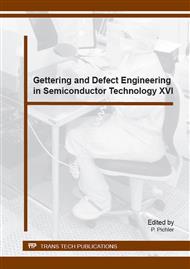[1]
A. A. Istratov, R. Sachdeva, C. Flink, S. Balasubramabian, E. R. Weber, Solid State Phenomena 82-84 (2002) 323.
Google Scholar
[2]
J.E. Lawrence and H.R. Huff, Silicon Material Properties for VLSI Circuitry, in: VLSI Electronics: Microstructure Science Vol. 5, ed. by: N. G. Einspruch, (Academic Press, New York, 1982) pp.51-102.
DOI: 10.1016/b978-0-12-234105-2.50007-0
Google Scholar
[3]
S. Takasu, VLSI Science and Technology / 1984, ed. by K. E. Bean and G. A. Rozgonyi, The Electrochemical Society, Proc. Vol. 84-7, 490 (1984).
Google Scholar
[4]
H. Richter, Proc. 1st Int. Autumn School Gettering and Defect Engineering in the Semiconductor Technology (GADEST), Oct. 8-18, 1985, Garzau, GDR, p.1.
Google Scholar
[5]
G. A. Rozgonyi, R. P. Deysher, and C. W. Pearce, J. Electrochem. Soc. 123 (1976) (1910).
Google Scholar
[6]
T. Y. Tan, E. E. Gardner, and W. K. Tice, Appl. Phys. Lett. 30 (1977) 175.
Google Scholar
[7]
G. A. Rozgonyi and C. W. Pearce, Appl. Phys. Lett. 32 (1978) 747.
Google Scholar
[8]
Y. Hirano, K. Yamazaki, F. Inoue, K. Imaoka, K. Tanahashi, and H. Yamada-Kaneta, J. Electrochem. Soc. 154 (2007) H1027.
DOI: 10.1149/1.2792322
Google Scholar
[9]
K. Izunome, Proceedings of the 6th Int. Symposium on Advanced Science and Technology of Silicon Materials (JSPS Symposium), Nov. 19-23, 2012, Kona, Hawaii, USA, pp.9-13.
Google Scholar
[10]
K. Graff, Metal Impurities in Silicon-Device Fabrication in: Springer Ser. Mater. Sci. 24 (1995).
Google Scholar
[11]
M. Seacrist, M. Stinson, J. Libbert, R. Standley, and J. Bins, in Semiconductor Silicon/2002, H. R. Huff, L. Fabry and S. Kishino, Editors, PV 2002-2, p.638, The Electrochemical Proceedings Series, Pennington, NJ (2002).
Google Scholar
[12]
D. Kot, G. Kissinger, M. A. Schubert, A. Sattler, and T. Müller, Solid State Phenom. 205-206, (2014) 278.
Google Scholar
[13]
E. R. Weber, Appl. Phys. A 30 (1983) 1.
Google Scholar
[14]
M. B. Shabani, Y. Shiina, F. G. Kirscht, Y. Shimanuki, Mat. Sci. Eng. B 102 (2003) 238.
Google Scholar
[15]
M. B. Shabani, T. Yoshimi, H. Abe, J. Electrochem. Soc. 143 (1996) (2025).
Google Scholar
[16]
R. Hölzl, L. Fabry, K. -J. Range, R. Pech, Appl. Phys. A 74 (2002) 545.
Google Scholar
[17]
R. Hölzl, K. J. Range, L. Fabry, Appl. Phys. A 75 (2002) 591.
Google Scholar
[18]
L. Fabry, R. Hölzl, A. Anmdrukhiv, K. Matsumoto, J. Qiu, S. Koveshnikov, M. Goldstein, A. Grabau, H. Horie, R. Takeda, J. Electrochem. Soc. 153 (2006) G566.
DOI: 10.1149/1.2186799
Google Scholar
[19]
M. B. Shabani, S. Okuuchi, T. Yoshimi, T. Shingyoji, F. G. Kirscht, Proc. High Purity Silicon V, ed. by: C. L. Claeys, P. Rai-Choudhury, M. Watanabe, P. Stallhofer, H. J. Dawson, in: Electrochem. Soc. Proc. 98-13 (1998) 313.
Google Scholar
[20]
K. -S. Kim, S. -W. Lee, H. -B. Kang, B. -Y. Lee, S. -M. Park, J. Electrochem. Soc. 155 (2008) H912.
Google Scholar
[21]
A. A. Istratov, E. R. Weber, J. Electrochem. Soc. 149 (2002) G21.
Google Scholar
[22]
J. H. An, J. S. Kim, J. Y. Kim, K. S. Lee, H. B. Kang, B. S. Moon, S. H. Lee, Y. Shin, S. M. Hwang and H. Y. Park, ECS Transactions, 50, 319 (2012).
Google Scholar
[23]
D. Kot, G. Kissinger, A. Sattler, and T. Müller, Acta Physica Polonica A 125 (2014) 965.
Google Scholar
[24]
K. Hozawa, S. Isomae, J. Yugami, Jpn. J. Appl. Phys. 41 (2002) 5887.
Google Scholar
[25]
K. Hozawa, J. Yugami, Jpn. J. Appl. Phys. 43 (2004) 1.
Google Scholar
[26]
S. -W. Lee, Y. -H. Kim, K. -S. Kim, B. -S. Hong, B. -Y. Lee, J. Korean Phys. Soc. 48 (6) (2006) 1548.
Google Scholar
[27]
R. J. Falster, G. R. Fisher, and G. Ferrero, Appl. Phys. Lett., Vol. 59 (1991) 809.
Google Scholar
[28]
D. Kot, G. Kissinger, W. Häckl, A. Sattler, W. von Ammon, ECS Transactions, Vol. 16(6) (2008) 207.
Google Scholar
[29]
B. Shen, T. Sekiguchi, J. Jablonski, K. Sumino, J. Appl. Phys., Vol. 76 (1994) 4540.
Google Scholar
[30]
E. R. Weber, Impurity Precipitation, Dissolution, Gettering, and Passivation in PV Silicon, Final Technical Report, February 2002, NREL/SR-520-31528.
DOI: 10.2172/15000243
Google Scholar
[31]
K. Sueoka, S. Ohara, S. Shiba, S. Fukatani, ECS Transactions, Vol. 2 (2006) 261.
Google Scholar
[32]
P. Bai, G. R. Yang, and T. M. Lu, J. Appl. Phys., Vol. 68 (1990) 3313.
Google Scholar
[33]
M. Yonemura, K. Sueoka, K. Kamei, J. Appl. Phys., Vol. 88 (2000) 503.
Google Scholar
[34]
S. Isomae, H. Ishida, T. Itoga, K. Hozawa, J. Electrochem. Soc., Vol. 194 (2002) G343.
DOI: 10.1149/1.1475694
Google Scholar
[35]
F. Secco d'Aragona, J. Electrochem. Soc., Vol. 119 (1972) 948.
Google Scholar
[36]
D. Kot, G. Kissinger, A. Sattler, W. von Ammon, ECS Transactions, Vol. 25(3) (2009) 67.
Google Scholar
[37]
R. Hölzl, M. Blietz, L. Fabry, R. Schmolke, Proc. Semiconductor Silicon 2002, ed. by H. R. Huff, L. Fabry, S. Kishino, in: Electrochem. Soc. Proc. Vol. 2002-2 (2002) 608.
Google Scholar
[38]
J. Vanhellemont, J. Appl. Phys., Vol. 78 (1995) 4297.
Google Scholar
[39]
J. C. Mikkelsen, Jr., in Oxygen, Carbon, Hydrogen, and Nitrogen in Silicon, edited by I. C. Mikkelsen, Jr., S. J. Pearton, J. W. Corbett, and S. J. Pennycook (Materials Research Society, Princeton, NJ, 1986), p.19.
Google Scholar
[40]
E. Nes and J. Washburn, J. Appl. Phys., Vol. 44 (1973) 3682.
Google Scholar
[41]
G. Das, J. Appl. Phys., Vol. 44 (1973) 4459.
Google Scholar
[42]
N. Fujita, R. Jones, S. Öberg, P. R. Briddon, and A. T. Blumenau, Solid State Phenomena, Vols. 131-133 (2008) 259.
DOI: 10.4028/www.scientific.net/ssp.131-133.259
Google Scholar
[43]
H. Väinölä, M. Yli-Koski, A. Haarahiltunen, J. Sinkkonen, J. Electrochem. Soc. 150 (2003) G790.
DOI: 10.1149/1.1624845
Google Scholar


